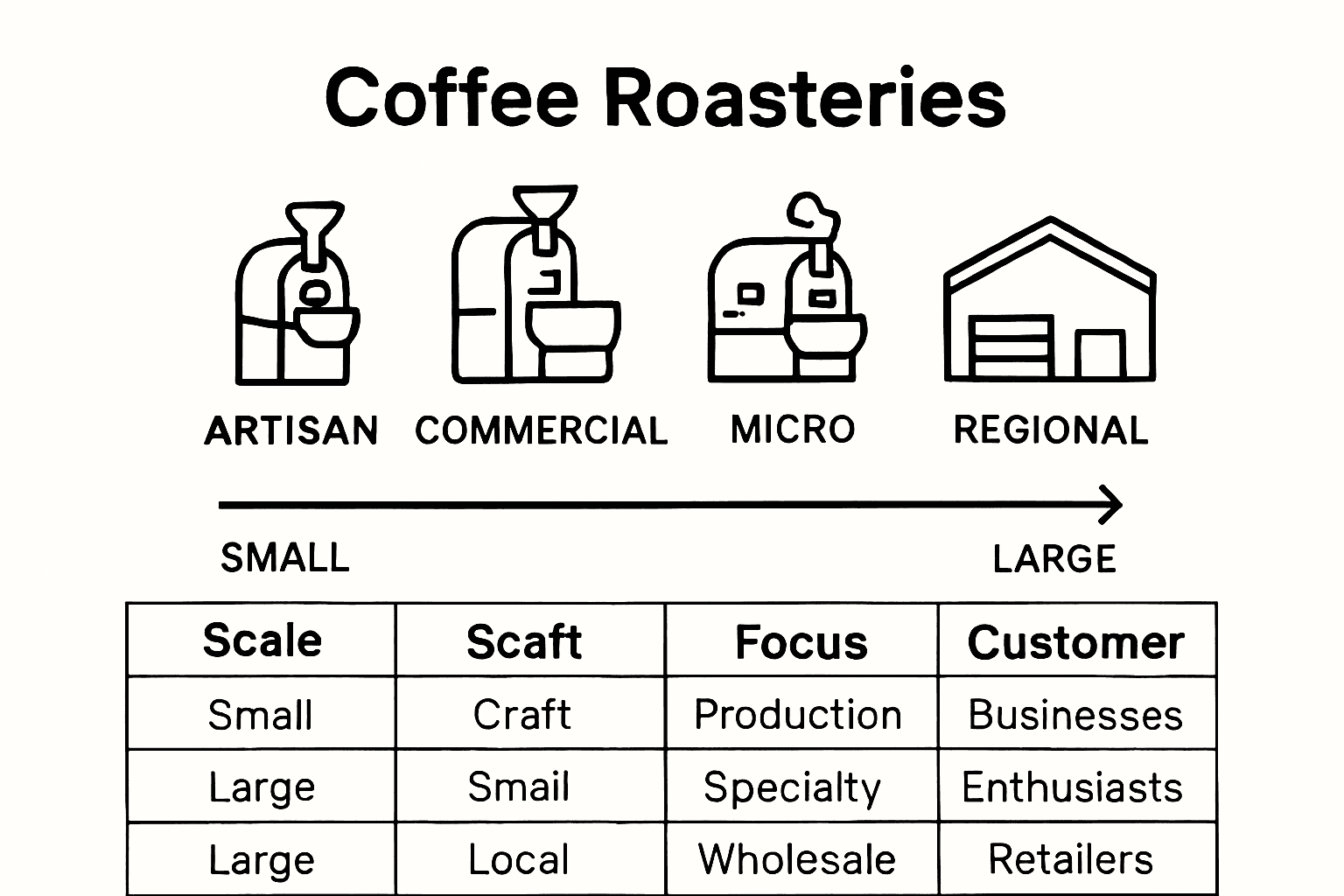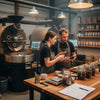What Is a Coffee Roastery? Complete UK Guide
- by Rock Roasters
Did you know that over two billion cups of coffee are consumed every day worldwide? The journey from raw bean to your morning brew starts in places most people never see. Coffee roasteries play a crucial role in shaping each cup’s unique aroma and taste, blending science with skill. Understanding what sets these facilities apart reveals how your favorite coffee gets its distinctive character and why every roast holds a story worth discovering.
Key Takeaways
| Point | Details |
|---|---|
| Core Role of Roasteries | Coffee roasteries specialize in transforming green coffee beans into aromatic final products through careful roasting processes. |
| Types of Roasteries | Coffee roasteries are classified into artisan, commercial, micro, and regional types, each with distinct approaches and focuses. |
| Roasting Process | The coffee roasting process includes drying, browning, and development phases, each crucial for flavor profile optimization. |
| Quality and Safety Standards | Roasteries must adhere to rigorous quality standards and legal regulations, ensuring consumer safety and product transparency. |
Table of Contents
- Defining A Coffee Roastery And Its Core Role
- Types Of Coffee Roasteries And Their Distinctions
- How Coffee Roasting Works: Process Steps
- Quality Standards And Sourcing Practices
- Legal And Safety Requirements In The UK
- Common Challenges And How To Avoid Mistakes
Defining a Coffee Roastery and Its Core Role
A coffee roastery is a specialised facility where green coffee beans are transformed into the aromatic, flavourful beans we know and love. Unlike a typical coffee shop or café, a roastery focuses on the critical process of roasting raw coffee beans to enhance their unique flavour profiles and bring out their inherent characteristics. At its core, a roastery is both a craft workshop and a culinary art studio where skilled roasters carefully develop each batch of beans.
The primary role of a coffee roastery involves several key stages of coffee preparation. First, roasters meticulously select high-quality green coffee beans from specific regions and farms, considering factors like altitude, soil conditions, and harvesting techniques. Then, through precise temperature control and timing, they apply heat to transform these raw beans, developing complex flavour notes, reducing moisture content, and creating the rich brown colour we associate with roasted coffee. Learn more about our roasting process in our guide on Jersey’s coffee craftsmanship.
Each roastery has its unique approach, with roast masters developing signature techniques that distinguish their coffee. Some focus on light, bright roasts that preserve delicate fruit and floral notes, while others create deeper, more robust profiles with intense caramel and chocolate undertones. The roasting process is part science, part art, requiring deep knowledge of bean origins, roasting curves, and flavour development. A great roastery doesn’t just sell coffee - it tells a story through each carefully crafted batch, connecting coffee lovers with the incredible journey from farm to cup.
Types of Coffee Roasteries and Their Distinctions
Coffee roasteries can be classified into several distinct categories, each with unique characteristics and approaches to transforming green coffee beans. Artisan roasteries represent the craft-focused end of the spectrum, where small-batch roasting allows for meticulous attention to detail and experimentation with flavour profiles. These roasteries typically work with specialty beans from specific regions, prioritising quality and unique taste experiences over volume.
Commercial roasteries operate at a much larger scale, focusing on consistent production and widespread distribution. As demonstrated by Costa Coffee, which began as a wholesale coffee roastery in London in 1971, these operations supply coffee to cafés, restaurants, and retail chains, ensuring uniform taste and quality across multiple locations. Explore our roaster’s approach to craft and consistency in our detailed notes.
Between these two extremes lie micro-roasteries and regional roasteries, which balance artisan techniques with slightly larger production capacities. These roasteries often maintain strong connections to local coffee communities, supporting regional farmers and creating unique blends that reflect local tastes and preferences. Whether focused on small-batch crafting or large-scale production, each roastery contributes to the rich tapestry of coffee culture, transforming humble beans into complex, aromatic experiences that connect consumers with global coffee traditions.

Here’s a summary of the main types of coffee roasteries and their distinctions:

| Roastery Type | Scale | Focus | Typical Customers |
|---|---|---|---|
| Artisan Roastery | Small batch | Craft, experimentation, quality | Coffee enthusiasts Specialty cafés |
| Commercial Roastery | Large scale | Consistency, volume, distribution | Retail chains Restaurants |
| Micro-Roastery | Very small batch | Local blends, unique profiles | Local cafés Home brewers |
| Regional Roastery | Medium | Community, regional identity | Local shops Regional blends |
How Coffee Roasting Works: Process Steps
The coffee roasting process is a delicate transformation that converts green, raw coffee beans into the aromatic, flavourful beans we brew and enjoy. Green coffee beans start as soft, grassy-smelling seeds with minimal flavour, requiring precise heat application to unlock their complex taste potential. The roasting journey begins with carefully selecting high-quality beans from specific regions, each with unique characteristics that will influence the final flavour profile.
Roasting occurs through several critical stages, typically divided into three main phases. First, the drying phase removes moisture from the beans, gradually increasing their internal temperature. As the beans heat up, they enter the browning phase, where complex chemical reactions start developing the beans’ signature flavours and aromas. During this stage, sugars begin to caramelise, and the beans transition from green to a warm, golden-brown colour. Discover more about our approach to brewing different coffee types in our brew guide.
The final stage is the development phase, where roasters make critical decisions about the bean’s final flavour intensity. Light roasts preserve more of the bean’s original characteristics, offering bright, acidic notes, while darker roasts create deeper, more robust flavours with pronounced caramel and chocolate undertones. Skilled roasters carefully monitor temperature, time, and bean colour, using both scientific precision and artistic intuition to create a perfectly roasted batch that captures the unique essence of each coffee’s origin.
Quality Standards and Sourcing Practices
Coffee sourcing represents a critical foundation for exceptional roasting, where quality begins long before beans touch a roaster’s drum. Premium roasteries prioritise direct relationships with coffee farmers, focusing on sustainable agricultural practices, fair compensation, and exceptional bean quality. These partnerships allow roasters to trace each bean’s journey, understanding its precise origin, cultivation methods, and potential flavour characteristics.
The evaluation of coffee beans follows rigorous quality grading standards, typically using the Specialty Coffee Association (SCA) scoring system. Beans are meticulously assessed across multiple dimensions, including aroma, flavour, aftertaste, acidity, body, balance, and overall consistency. Learn more about our commitment to quality sourcing in our wholesale guide, which highlights our dedication to selecting only the most exceptional beans from carefully vetted producers.
Ethical sourcing goes beyond simple transactions, encompassing environmental sustainability, worker welfare, and community development. Responsible roasteries invest in programs that support local farming communities, provide technical training, and create economic opportunities in coffee-producing regions. By prioritising transparent supply chains and supporting regenerative agricultural practices, these roasteries ensure that every cup of coffee represents not just a beverage, but a positive impact on global coffee-growing communities.
Legal and Safety Requirements in the UK
Coffee roasteries in the United Kingdom must navigate a complex landscape of food safety regulations that ensure consumer protection and maintain high standards of production. The primary legal framework governing coffee roasting operations includes the Food Safety Act 1990, which mandates that all food businesses implement comprehensive food safety management systems based on Hazard Analysis and Critical Control Points (HACCP) principles. These regulations require roasteries to demonstrate meticulous control over every stage of coffee processing, from bean selection to packaging.
Workplace safety represents another critical legal consideration for coffee roasting businesses. The Health and Safety at Work Act 1974 imposes strict requirements on managing risks associated with high-temperature roasting equipment, potential fire hazards, and potential respiratory risks from coffee dust. Roasteries must provide appropriate personal protective equipment, maintain comprehensive risk assessments, and ensure proper ventilation systems to protect worker health. Explore our commitment to safety and quality in our wholesale operations.
Beyond operational safety, UK roasteries must also comply with complex food labelling regulations outlined in the Food Information Regulations 2014. These guidelines mandate detailed ingredient listings, allergen information, nutritional declarations, and clear traceability information. Roasteries must maintain meticulous records of bean origins, roasting dates, and batch information, ensuring complete transparency for consumers and regulatory bodies. By adhering to these comprehensive legal standards, coffee roasteries demonstrate their commitment to quality, safety, and consumer trust.
Common Challenges and How to Avoid Mistakes
Coffee roasting is a complex craft where seemingly minor errors can dramatically impact final product quality. One of the most common challenges is inconsistent roasting, which occurs when roasters fail to maintain precise temperature control or neglect to monitor bean progression carefully. Experienced roasters understand that each bean variety requires unique roasting parameters, and blindly applying a standard approach can result in burnt, underdeveloped, or flavourless coffee.
Another significant challenge involves bean selection and storage. Improper green bean storage can lead to moisture degradation, loss of essential oils, and compromised flavour profiles. Roasteries must invest in climate-controlled environments that protect beans from humidity, direct sunlight, and temperature fluctuations. Learn more about our approach to maintaining coffee quality in our brew guide, which highlights the critical importance of proper bean preservation.
Perhaps the most nuanced challenge is achieving consistent flavour profiles across different batches. This requires masterful understanding of bean origins, roasting techniques, and subtle variations in raw materials. Successful roasteries develop comprehensive tracking systems, maintain detailed roasting logs, and continuously calibrate their equipment. By embracing a scientific approach combined with artistic intuition, roasters can transform potential mistakes into opportunities for innovation and exceptional coffee creation.
Experience the Real Craft of Coffee Roasting
You have seen how the right roasting process transforms green beans into an extraordinary cup of coffee. If you care about quality, consistency and flavour, you know that poor roasting or improper bean storage leaves you with bland, bitter coffee and a disappointing start to your day. At Rock Roasters, our small batch coffee roasting is all about avoiding those mistakes. We meticulously source, roast and package our beans in the Channel Islands, so every bag genuinely tells the story of its origin.

Stop settling for generic blends. Make your next cup exceptional by choosing expertly roasted coffee that reflects years of experience and real passion for the craft. Visit Rock Roasters to discover our full range of coffees or explore our flexible coffee subscriptions and never risk an average brew again. Shop now and taste the difference real roasting makes.
Frequently Asked Questions
What is the main purpose of a coffee roastery?
A coffee roastery transforms green coffee beans into roasted beans by applying heat to enhance their flavour profiles and bring out their inherent characteristics.
What are the key stages in the coffee roasting process?
The coffee roasting process involves three main phases: the drying phase, the browning phase, and the development phase, each critical for developing the beans’ flavours and aromas.
How do artisan roasteries differ from commercial roasteries?
Artisan roasteries focus on small-batch roasting with meticulous attention to quality and unique flavour experiences, while commercial roasteries prioritize consistency and volume for widespread distribution.
What quality standards are involved in coffee sourcing for roasteries?
Premium roasteries adhere to rigorous quality grading standards, focusing on direct relationships with farmers, sustainable practices, and transparency in the supply chain to ensure high-quality beans.
Recommended
- Posted in:
- what is a coffee roastery





